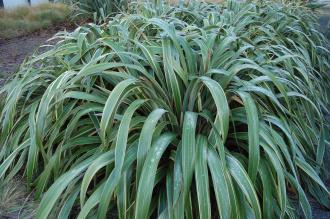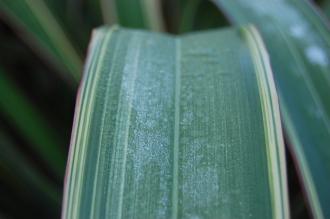
Phormium cookianum ‘Tricolor’ (30/12/14, Kew Gardens, London)
Position: Full sun to partial shade
Flowering period: Summer
Soil: Moist, well drained
Eventual Height: 1m
Eventual Spread: 1m
Hardiness: 8a, 8b, 9a, 9b, 10a
Family: Xanthorrhoeaceae
Phormium cookianum ‘Tricolor’ is an evergreen perennial with an upright habit. Its mid/ dark green leaves have yellow variegation running its length, are sword shaped with a central groove that runs its length and are up to 1.8m long. Its pale yellow/ green hermaphroditic flowers are tubular and borne in panicles. Its black fruit are twisted seed pods, these are initially green.
The species, Phormium cookianum, commonly known as Mountain Flax, New Zealand Flax or Wharariki, is native to New Zealand. Phormium cookianum is synonymous with Phormium colensol.
The etymological root of the binomial name of Phormium is derived from the Greek phormos meaning ‘basket’. Cookianum is named for Captain James Cook, the 18th century British navigator and explorer.
The landscape architect may find Phormium cookianum ‘Tricolor’ useful as a large evergreen perennial, particularly in maritime locations. It is tolerant of periodical flooding, even with saline water. It will tolerate short periods of drought once established.
Ecologically, Phormium cookianum ‘Tricolor’ flowers are attractive to many species of pollinating.

Phormium cookianum ‘Tricolor’ Leaf (30/12/14, Kew Gardens, London)
The Royal Horticultural Society gave the cultivars Phormium cookianum ‘Tricolour’ their prestigious Award of Garden Merit in 1993.
Phormium cookianum ‘Tricolor’ prefers moist, fertile, well-drained soils. It tolerates most pH of soil.
Phormium cookianum ‘Tricolor’ requires little to no maintenance. Dead or damaged material may be removed in spring. Large clumps may be lifted and divided in spring.

